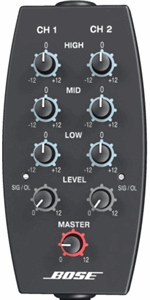Difference between revisions of "R1 Remote"
m |
m |
||
| Line 22: | Line 22: | ||
== Wiring It == | == Wiring It == | ||
| − | === | + | === Two R1 Remotes for One PS1 Powerstand === |
Can I have more than one R1 Remote connected to a single PS1 Powerstand? | Can I have more than one R1 Remote connected to a single PS1 Powerstand? | ||
| Line 28: | Line 28: | ||
[http://bose.infopop.cc/eve/forums/a/tpc/f/3976055944/m/7891042462/r/3151052462#3151052462 Daisy Chain Remotes?] | [http://bose.infopop.cc/eve/forums/a/tpc/f/3976055944/m/7891042462/r/3151052462#3151052462 Daisy Chain Remotes?] | ||
| − | === One Remote for Two Powerstands === | + | === One R1 Remote for Two PS1 Powerstands === |
There are two connections on the R1 Remote. Can I connect two PS1 Powerstands and control them simultaneously? | There are two connections on the R1 Remote. Can I connect two PS1 Powerstands and control them simultaneously? | ||
Revision as of 22:04, 21 August 2006
R1 Remote
These are tips for living with the R1 Remote Control Unit
Contents
Packing It
Ken-at-Bose [1] says
Don't put the Remote Control in the outside pocket of the Power Stand gig bag. It'll get hit during transportion.
The gig bag for the upper half of the Cylindrical Radiator(tm) speaker is designed to leave room for the Remote alongside the bayonet; this is a good protected area.
Stiff Controls
If the knobs get stiff, you can pull them out a bit. Chances are they've just gotten jammed down during packing.
Is it Required
If you power up the System without the Remote Connected, the PowerStand operates as though the Remote is connected with all controls straight-up (12 o'clock) position.
The PS1 power stand continuously senses activity at all preset selectors and what is connected at the input/output jacks. In general, it is not recommended to operate without the remote connected. The PS1 power stand can however function without the R1 remote control. If you power the PS1 power stand on without the R1 remote control connected, it will operate as if the R1 remote control was connected and at a fixed setting of 12 o'clock (center position) on all the control knobs. Alternatively, if the unit is powered on with the R1 remote control first connected and the user then disconnects the R1 remote control, it will retain the last settings of the R1 remote control before you disconnected it. This is helpful in the case where sharing may be necessary.
Source: Official Bose FAQ
Wiring It
Two R1 Remotes for One PS1 Powerstand
Can I have more than one R1 Remote connected to a single PS1 Powerstand?
No - Please don't try to connect more than one Remote to a Power Stand (or more than One Power Stand to a Remote) Daisy Chain Remotes?
One R1 Remote for Two PS1 Powerstands
There are two connections on the R1 Remote. Can I connect two PS1 Powerstands and control them simultaneously?
No.
Vocals on the Left
I always wire up the PowerStand so that the vocals are in Channel 1. This just means that it's always the same, easy to describe, and one less thing to wonder about. (exception below)
Two Players
If you've got two players sharing a System, and hence the Remote, take a moment to wire things up so that the Channel strip that affects someone's sound is closest to them.
Leave 'em Hanging - (not)
 Here's an idea for a bracket you can mount on the mic stand. Sure, the velcro is fine but ...
Here's an idea for a bracket you can mount on the mic stand. Sure, the velcro is fine but ...
Musicians Friend link to bracket
Zipper Sounds, Latency
Hilmar-at-Bose [2]
...there are two design related issues that come into play here. The reason why nearly nobody knows about is, is that rarely ever anyone notices it.
1) The remote has a certain amount of latency. It takes a moment from the time you turn a knob until the setting actually takes effect. The exact time depends on the circumstances, but it's always less than one tenth of a second which is indeed barely (if at all) noticable.
2) The Channel 1 and 2 Volume controls produce a very slight "zipper" noise when they change between different volume setting. That noise does not affect the tone controls or the master volume. The technical reasons for that are complicated, but I'm happy to explain it, if someone is interested. Anyway, the "zipper" noise only occurs when you actually operate the control, so it doesn't occur while playing unless you play and adjust at the same time. If you need to do that (e.g. for a fade-out) and the zipper is audible and objectionable, you could maybe use the volume control on your instrument or the master volume on the remote.
Again, most people never notice these issues in the first place and if they do, it's rarely a problem of any sort.
Muting
Channel 1 and 2 Controls on the Remote don't mute the channels. quote: Quoting Hilmar-at-Bose The channel volume controls have about 40 dB gain from all-the-way-down to all-the-way-up but don't completely mute the sound.
See it in context: Volume Control on the Remote
